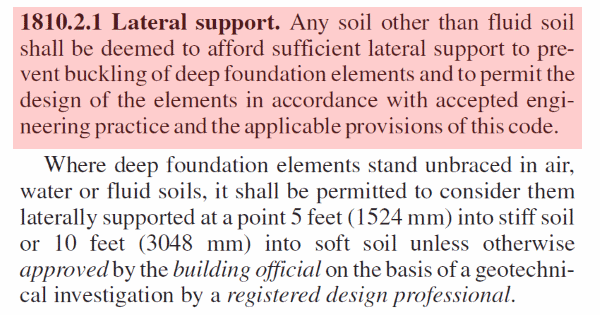struct_eeyore
Structural
Hi all.
For those of you familiar with the requirements for pile bracing... I've previously interpreted 1810.2.2 of the IBC, in a grade-beam/pile constriction context, as requiring the grade beams to be able to take lateral forces out from the pile at right angles. In particular, in any soil requiring piles (that soil is just assumed to be air), all the piles should be locked-in in this manner, outstanding the exception that allows you to stagger piles 1' o.c. along a grade beam; or, if you have a slab directly attaching to the piles/caps. Previous company I've worked at, this was the interpretation as well, and all our pile buildings were designed with this in mind. Yesterday I was reviewing a set of drawings that has gone out, and noticed the piles were not braced. The building is on organics. I brought it up with the senior engineer, and he dismissed this as not needing any additional bracing, stating that only piles above grade need lateral. In particular, the design as of right now has an ~40' grade beam, with piles equally spaced (the only grade beams that would provide bracing are at the ends of the beam); on top of the grade beam is a 6-7' stem wall with back-fill behind it - the stem wall is capped with a slab. The backfill presents another problem, in that I'm getting about 3k of lateral at the top of the pile, whereas the allowable (from geotech) is about 2. The total gravity load acting on the stem wall is about 3400 plf, so that will result in additional lateral as well from any eccentricity. Piles are augercast. So naturally, my question is: is there anything at all that I'm not considering that will make this ok? Can anyone comment on the likelihood and means of failure of such construction? And on a personal note - how much should I escalate this?
Thanks in advance
For those of you familiar with the requirements for pile bracing... I've previously interpreted 1810.2.2 of the IBC, in a grade-beam/pile constriction context, as requiring the grade beams to be able to take lateral forces out from the pile at right angles. In particular, in any soil requiring piles (that soil is just assumed to be air), all the piles should be locked-in in this manner, outstanding the exception that allows you to stagger piles 1' o.c. along a grade beam; or, if you have a slab directly attaching to the piles/caps. Previous company I've worked at, this was the interpretation as well, and all our pile buildings were designed with this in mind. Yesterday I was reviewing a set of drawings that has gone out, and noticed the piles were not braced. The building is on organics. I brought it up with the senior engineer, and he dismissed this as not needing any additional bracing, stating that only piles above grade need lateral. In particular, the design as of right now has an ~40' grade beam, with piles equally spaced (the only grade beams that would provide bracing are at the ends of the beam); on top of the grade beam is a 6-7' stem wall with back-fill behind it - the stem wall is capped with a slab. The backfill presents another problem, in that I'm getting about 3k of lateral at the top of the pile, whereas the allowable (from geotech) is about 2. The total gravity load acting on the stem wall is about 3400 plf, so that will result in additional lateral as well from any eccentricity. Piles are augercast. So naturally, my question is: is there anything at all that I'm not considering that will make this ok? Can anyone comment on the likelihood and means of failure of such construction? And on a personal note - how much should I escalate this?
Thanks in advance


![[idea] [idea] [idea]](/data/assets/smilies/idea.gif)